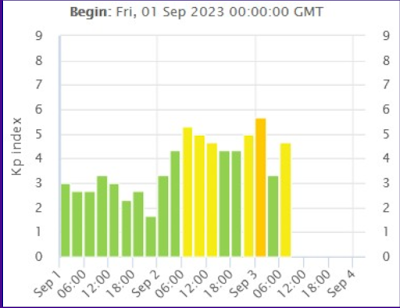 Been there done that but it seems I am now doing it again!
Been there done that but it seems I am now doing it again!
In quest to be frugal and when ham bucks are needed for a purchase I have in the past taken a look around the shack and put up for sale items that I just were not using or felt I would no long need. Way to often I have found this practice has bitten me more than one time. How many of you have sold a piece of equipment to later find you need it!
I have done that with too many items and it can get very frustrating but I do have to understand that in some cases the new piece of gear that was purchased would never had happened if I did not liquidate some gear. Here are some of the items I have sold and turned around to only purchase the same item later on down the line. LG auto tuner, external SWR meter, noise cancelling unit, antenna switch, Asus Xonar U7 external sound card and the list goes on. Actually it goes on to my most recent purchase the K1EL Winusb keyer, yup had one and sold it and now I need it.
How many of you out there have done the same thing? I have now learned my lesson as I am keeping on my self the external SWR meter, antenna switch and Astron power supply just in case I need them. I have become a ham horder.
Mike Weir, VE9KK, is a regular contributor to AmateurRadio.com and writes from New Brunswick, Canada. Contact him at [email protected].
 Amateur Radio Weekly – Issue 297
Amateur Radio Weekly – Issue 297
The return of RadioShack?
Under its new management, RadioShack is doing pretty well.
Sound and Vision
FreeDV project update
Integrations with FreeDATA capable of sending data down to around -8dB on poor quality HF channels.
Rowetel
Ham Imports
A comprehensive catalog of low-cost radios coming out of China.
Ham Imports
ESP32 APRS tracker
A small form factor, feature rich APRS tracker, digipeater, igate, and modem.
RPC Electronics
Decoding space weather data for HF communication
Publicly available ionospheric data to help you operate on HF.
N6CTA
Long wave radio fans mourn fading frequencies
The band is basically almost dead.
BBC
Titanic: Government filed motion to block salvage of the ship’s wireless telegraph
This important machine was used to transmit a distress call when the ship was sinking.
artnet
USB-C power for Ham Radio
Most HTs lack a modern USB-C port.
Hackaday
Video
RTL SDR V4 with built-in HF upconverter
Vast improvements made over the V3, especially for HF reception.
Tech Minds
1 Watt POTA activation
1 Watt QRP SSB Challenge to test the N9SAB 40-6m off-center-fed dipole.
N2MAK
End the Ham Radio FCC symbol rate limit
The push to move from Symbol Rate to Bandwidth Rate limits for data.
Ham Radio Crash Course
Umbrella Antennas
Building a radio telescope from an umbrella and copper cloth.
Society of Amateur Radio Astronomers
Get Amateur Radio Weekly in your inbox.
Sign-up here
Amateur Radio Weekly is curated by Cale Mooth K4HCK. Sign up free to receive ham radio's most relevant news, projects, technology and events by e-mail each week at http://www.hamweekly.com.
 Extra License Class – Palmer Lake, CO
Extra License Class – Palmer Lake, CO
Ham Radio Extra License Class
Palmer Lake, Colorado
Sat Oct 21 through Sat Nov 4, 2023
- Two all-day in-person sessions Oct 21 and Nov 4 (8 AM to 5 PM)
Palmer Lake Town Hall, 42 Valley Crescent Street, Palmer Lake, CO, 80133 - Additional 8 hours of Zoom & video sessions (scheduling TBD)
- Students are expected to attend all scheduled sessions.
The Extra License is the top amateur license, providing full access to the FCC Amateur Radio Service band allocations.
- Upgrade from General to Extra Class radio privileges
- Pass your FCC Extra Class amateur license exam
- Live equipment demonstrations and activities
- Expand your HF ops on 15-, 20-, 40-, & 80-meter bands
- Gain a deeper understanding of radio electronics and theory
- Take the next step with antennas, amplifiers, digital modes
Registration fee: $40
In addition, students must have the required study guide:
Ham Radio School Extra License Course
First Edition, effective 2020 – 2024, $29.95
A current FCC General License is required for registration.
For more information and to register, go here:
https://w0tlm.com/radio-classes/extra-registration
Questions, email: [email protected]
Sponsored by the
Tri-Lakes Monument Radio Association
www.w0tlm.com
The post Extra License Class – Palmer Lake, CO appeared first on The KØNR Radio Site.
Bob Witte, KØNR, is a regular contributor to AmateurRadio.com and writes from Colorado, USA. Contact him at [email protected].
 Mt Ojibway (W8M/UP-002) – Isle Royale National Park
Mt Ojibway (W8M/UP-002) – Isle Royale National Park
Joyce/K0JJW and I enjoy visiting the National Parks in the US, an activity that naturally combines with Summits On The Air (SOTA) and Parks On The Air (POTA). While planning a visit to Isle Royale National Park in upper Michigan, we decided to activate at least one SOTA summit as well as activate the park for POTA. The park is one large island surrounded by many smaller ones, accessible by boat or airplane. The park is actually closer to Canada than the US mainland.

There is quite a bit of information about visiting the park on the Isle Royale National Park website, so I won’t repeat that here. We opted to take the Isle Royale Queen IV ferry from Copper Harbor, MI to and from the island and stay for three nights at Rock Harbor Lodge on the northeast end of the park.
The closest SOTA summit to Rock Harbor is Mount Ojibway (W8M/UP-059), which soon became the objective for our SOTA activation. This summit had been activated only once, by Scott/WA9STI in 2017. I contacted Scott, who was very helpful in sharing his experience on Ojibway. (There are three other SOTA summits in the park, with first activations by Mark/NK8Q.)
We had four friends join us on this trip, including the hike to Mount Ojibway. Two of them were licensed radio amateurs: Paul/KF9EY and Beth/KB9DOU with Paul joining us in doing the SOTA activation.
Trip Planning
We normally do SOTA activations using VHF/UHF, so this raised the issue of whether that was possible given the remote nature of the island. I poked around on the interwebz and reached out to radio clubs on both the US and Canadian sides. Randy/VA3OJ in Thunder Bay and Bill/KD8JAM on the Keweenaw Peninsula were particularly helpful and they both confirmed they can work stations on Isle Royale from their locations using 2m FM. The distance is not that far, especially to the Canadian side, and it is a straight shot over water.
There were two things that I worried about on this activation: bugs and rain, neither of which were under our control. For bugs, we loaded up on a variety of insect repellents and head nets. However, once we arrived at the island, it was pretty clear the bugs were not bad at all, probably because we were late enough in the year (late August). For the rain, we made sure we had rain gear and synthetic clothes, with the attitude of expecting to get soaked and being able to survive it.
There was no internet on the island (the lodge says they have it but it was not working). Occasionally we would get 1 bar of Verizon LTE service at Rock Harbor but is was not reliable. This meant that we were very limited in sending any email updates out to people. I emailed our plans to interested parties and posted an Alert on SOTAwatch before we hopped on the ferry.

For equipment, we decided to take our Icom IC-705 and an external battery pack for 10 watts of RF on all bands of interest. Our priority was VHF but we also took along antennas for 40m through 10m. In addition, I configured an iPad for FT8 but we did not end up using that capability.
Mount Ojibway is about a 7-mile hike from the Rock Harbor Lodge, so we decided to have the water taxi drop us off at Daisy Farm Campground and hike in from there, which is about 2 miles one way. We also scheduled the water taxi to pick us up for the return trip. So this set us up for a 4-mile round trip hike with modest elevation gain.
Activation Day
On the morning of our activation, a thunderstorm rolled into Rock Harbor delivering a good dose of lightning to the area. I checked on the status of the water taxi and it was uncertain whether it would be running due to the storm. We sat tight and the weather cleared up enough such that we could go. Still, it was cloudy and the forecast included some rain in the afternoon. I told our group, “We are going to get wet today.”
 Mount Ojibway at 1150 feet is part of the Greenstone Ridge that runs along the top of the island. It is also the location of an observation tower, now used as a radio site. The SOTA database shows the summit a bit to the northeast of the tower and the ridge is quite flat with a broad activation zone. My GPS app showed our hike as 1.9 miles one-way, with 540 feet vertical. The trail is well-established and in good condition. There were several narrow boardwalks (narrow planks) over marshy areas that were unnerving for some of our group.
Mount Ojibway at 1150 feet is part of the Greenstone Ridge that runs along the top of the island. It is also the location of an observation tower, now used as a radio site. The SOTA database shows the summit a bit to the northeast of the tower and the ridge is quite flat with a broad activation zone. My GPS app showed our hike as 1.9 miles one-way, with 540 feet vertical. The trail is well-established and in good condition. There were several narrow boardwalks (narrow planks) over marshy areas that were unnerving for some of our group.

At the summit, we appreciated some blue sky and nice weather that appeared while we set up the IC-705 and 3-element Yagi for 2 meters. We called CQ SOTA on 146.52 MHz and soon worked KD8JAM and VA3OJ. We kept calling and picked up two more 2m FM contacts: W9GY and VA3DVE. About this time, we set up the endfed antenna for the HF bands and (just barely) worked W0BV in Colorado on 20m SSB. (My phone was not able to spot us but I used my Garmin inReach to message W0BV and he came up on frequency.) I also worked W4GO, who had a decent 55 signal at the summit. But 20m was not working very well for us and I started to consider what changes I should make to the station. However, the dark clouds approaching from the northwest made that a moot point as we packed up our gear and headed down the trail. Sorry, we were not able to do more on HF.
Totally Drenched
On the way down the summit, things got a bit more exciting, and not in a good way. The storm clouds moved in and the light rain we experienced off and on during the day turned into a downpour. My warning of “we are going to get wet today” became all too true. This is the kind of rain that turned the nice, well-developed trail into a river of flowing water. With the rain came lightning, not close by but close enough. We were walking through a well-established forest so the lightning exposure was not too bad. The muddy trail definitely slowed us down as we did not want to add injury to our adventure.
We all were thoroughly drenched by the time we arrived at Daisy Farm Campground. At that point, the storm quit and we hung out on the dock waiting for the water taxi to pick us up. The water taxi apparently had its schedule adjusted and arrived over an hour later than expected. I guess we were on island time.
It was a successful but wet activation. Thank you so much to the radio amateurs who worked us, especially KD8JAM and VA3OJ. We couldn’t have done it without you.
73 Bob K0NR
The post Mt Ojibway (W8M/UP-002) – Isle Royale National Park appeared first on The KØNR Radio Site.
Bob Witte, KØNR, is a regular contributor to AmateurRadio.com and writes from Colorado, USA. Contact him at [email protected].
 Hold on folks!
Hold on folks!
Now that I am retired long weekends seem to sneak up on me as when I was working it seemed they never could come fast enough. As with CW contesting they just don't seem to come fast enough but space weather has a way of sneaking up and spoiling the contest....well that is what I used to think anyway. In the past, I would faithfully check out the space weather to get a sniff of upcoming conditions for a weekend contest. If things looked rough I would either skip the contest or dip my toes in it just to see how the ride would go.
Recently I have changed my outlook on the dreaded solar storms. This weekend was the CWops open contest and it is divided into 3 sessions. I took part in the 2nd session only as I had other things on my agenda for the weekend. From 9 am local time to 1 pm is session 2 I jumped in even with a Kp index of 5. I understood it was going to be rough, and I most likely will not beat last year's score but I have decided to use the poor conditions to hone my CW skills.
In the past when calling CQ contest and having a station come back to me who was almost non-existent and fading in and out I struggled. Now I have the opportunity thanks to the poor solar conditions to practice this skill! I had a ton of fish on 40m and 20m just waiting for me to dig them out of the mud and toss and turn with them as we both faded in and out.
That was how I spent my 4 hours in session 2 of the CWops CW open contest. My score was not the greatest but that was not my goal and considering the poor conditions I would have been frustrated. Instead, I used it as a learning session to work weak and fading stations. When I say weak at times their signal was not even moving my S meter and fading as well.
Below is my final score and I ended up operating for 3 of the 4 hours as I started late by 30 minutes and I took some breaks.
Mike Weir, VE9KK, is a regular contributor to AmateurRadio.com and writes from New Brunswick, Canada. Contact him at [email protected].
 Ham College 104
Ham College 104
Ham College episode 104 is now available for download.
Extra Class Exam Questions – Part 42
E8D Keying defects and overmodulation of digital signals, digital codes, spread spectrum.
George Thomas, W5JDX, is co-host of AmateurLogic.TV, an original amateur radio video program hosted by George Thomas (W5JDX), Tommy Martin (N5ZNO), Peter Berrett (VK3PB), and Emile Diodene (KE5QKR). Contact him at [email protected].
 LHS Episode #514: Stupidity and Enlightenment
LHS Episode #514: Stupidity and Enlightenment
Hello and welcome to Episode #514 of Linux in the Ham Shack. In this short topics episode, the hosts discuss several stories including hacking trains with radio, new satellite launches, solar eclipse research, ZFS, Bodhi Linux and much more. Thanks for listening and have a great week.
73 de The LHS Crew
Russ Woodman, K5TUX, co-hosts the Linux in the Ham Shack podcast which is available for download in both MP3 and OGG audio format. Contact him at [email protected].


















